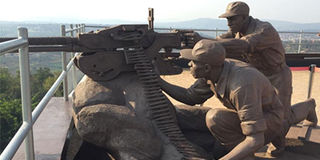OUT&ABOUT: The land of a thousand hills

A statue on the rooftop depicting soldiers battling against the Interhamwe at the Liberation Museum at Parliamentary building in Kigali. PHOTO| MARYANNE GICOBI
What you need to know:
- It shouldn't have surprised me then, that my muscles composed a protest song against the hilly terrain, and that they would sing this song on repeat every evening when I retired to bed.
- It was, after all, the land of a thousand hills.
Rwanda has been on my bucket list since 2011 when I read Hannah Jansen's Over a Thousand Hills I Walk with You. In the book, the author helps Jeanne, her adopted daughter, come to terms with her nightmarish memories of the Rwandan genocide.
I was particularly interested in visiting the Kigali Genocide Memorial which commemorates the brutal 1994 Rwandan genocide. I also wanted to experience have my share of the cleanliness and greenness of Kigali that everybody spoke so fondly about.
It shouldn't have surprised me then, that my muscles composed a protest song against the hilly terrain, and that they would sing this song on repeat every evening when I retired to bed. It was, after all, the land of a thousand hills.
DRAMATIC JOURNEY
The journey by bus from Kampala to Kigali was nothing short of dramatic. And in keeping with the hill metaphor, it was an uphill ordeal! I had heard of the twists and turns in one's stomach as one rode on the bus and wanted to feel the knots in my stomach on my own.
Two words for the bus experience: big mistake. The driver of the bus company whose name I can't reveal for the sake of my own safety, drove at approximately 170 kilometres per hour.
My travelling partner and I spent the night holding tightly to our seats lest we were thrown off it into the darkness, seeing as there were no working seat belts. In retrospect, I got the adventure I was looking for.

The entrance to the Kigali Genocide Memorial. Photos inside the museum are not allowed.
The thorough checks at the border is something you need to budget for as well, as we spent a good two hours there.
Just in case you are wondering, they were mostly interested in whether or not we were bringing plastics into the country. Exposing the entrails of our suitcases and bags to total strangers, as there is no privacy, was probably the only low point in the ordeal.
We arrived at about 9am and true to the country's reputation, even the bus station was surrounded by hills. Mugithi music blared from one of the stalls nearby, making us feel right at home.
The house we were staying in was strategically located, which meant that we could walk to most places but it was a heroic attempt we gave up on after a few attempts and resorted to either taxis or boda bodas.
The visit to the Kigali Genocide Memorial was a truly humbling experience that had us all in sombre moods, right from the reception area where a video was showcased to the museum itself where skeletons of those who were killed in the genocide are displayed.
No photos were allowed inside the museum but one does not need them to remember the experience as the words, videos and photos etch the experiences in your head. The museum is surrounded by a number of graves of the victims of the genocide as well. The entrance to the museum is free but one can donate money to keep it running.
The other must-see place is the Liberation Museum at Parliamentary building in Kigali. This is where visitors are taken through the military operations that brought the genocide to an end. Photography is not allowed inside this museum, either, but the life-like figures of the soldiers stay with you for a long, long time.
Our guide was a genocide survivor; a memory she refuses to dig up but offers:
“The perpetrators are suffering now more than we are because they can’t walk around with clear consciences. That’s enough punishment.”
The Kandt House Museum, also located in Kigali, offers glimpses of Rwanda's colonial history. Richard Kandt, who the museum is named after, was the first colonial governor of Rwanda, on behalf of Germany, until the early 1900s.
The other interesting place we visit is the Rwanda Conference Centre and the new stadium and both are a sight to behold if you fancy great architectural designs.
A visit to Kigali would be incomplete without stopping by Carwash Grill, which is said to have the best nyama choma in town. The crowd there is also drawn from various nationalities. The reviews about their nyama choma were spot on.
Perfectly salted, soft and juicy. The drinks, however, were overpriced, compared to what one would get from a similar outlet in Nairobi.
Rwanda is definitely one of those countries that one finds hard to say goodbye to; like a friend or lover you were just about to get to know when you suddenly have to leave.





